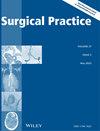Poster Round
IF 0.2
4区 医学
Q4 SURGERY
引用次数: 0
Abstract
Aim: Skin-staining characteristic of SPIO raises cosmetic concerns especially in the setting of breast conservative therapy (BCT). A comparison of skin stains from SPIO versus blue dye was performed as a predefined longterm analysis of a previously reported randomised controlled trial (RCT). Method: Following the RCT which was conducted between July 2018 and August 2022 to primarily study the efficacy of SPIO in sentinel lymph node detection, this follow-up analysis investigates skin stains in patients who received BCT. Patients with clinically node negative T1-3 invasive ductal or lobular carcinoma receiving surgeries were eligible. Study patients were given SPIO and radioisotope as tracers. Control patients were given blue dye and radioisotope. Skin stains were documented till 18 months postoperatively. Results: Ninety-eight patients have received BCT and completed 18 months of follow-up, of which 50 patients were in the study group and 48 were in the control group. Patients in the study arm had significantly larger and higher incidences of skin stains throughout the follow-up period in contrast to the control group. Larger volumes of breast tissue excised were associated with smaller incidences and sizes of skin stains from 6 months onwards ( p < .05). Younger patients were also found to have smaller skin stains by 18 months ( p = .04). Conclusion: Greater incidences and sizes of skin stains were observed in patients given SPIO. Excision of a larger breast volume was associated with faster skin stain clearance postoperatively. Cosmetic outcomes of SPIO should be discussed during patient counselling on treatment options for a personalised海报圆形
本文章由计算机程序翻译,如有差异,请以英文原文为准。
求助全文
约1分钟内获得全文
求助全文
来源期刊

Surgical Practice
医学-外科
CiteScore
0.90
自引率
0.00%
发文量
74
审稿时长
>12 weeks
期刊介绍:
Surgical Practice is a peer-reviewed quarterly journal, which is dedicated to the art and science of advances in clinical practice and research in surgery. Surgical Practice publishes papers in all fields of surgery and surgery-related disciplines. It consists of sections of history, leading articles, reviews, original papers, discussion papers, education, case reports, short notes on surgical techniques and letters to the Editor.
 求助内容:
求助内容: 应助结果提醒方式:
应助结果提醒方式:


